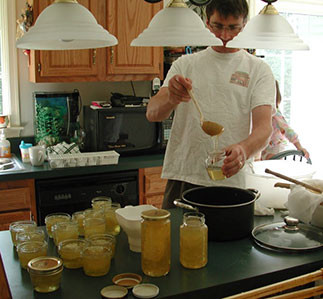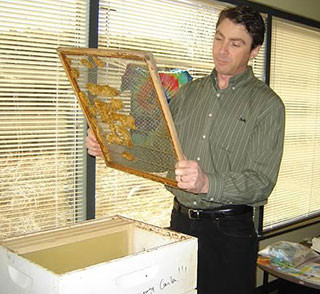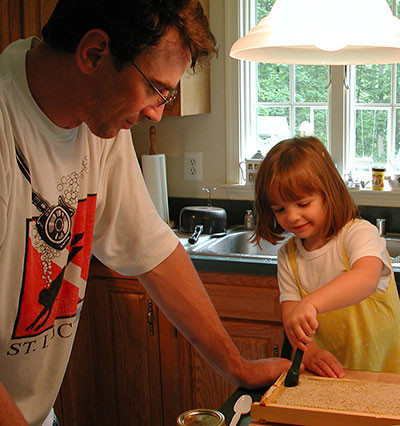My earliest encounters with beekeeping are painted with vivid memories of watching my grandfather on the hill behind his Jamesville, New York home. I was just a child, perched at a safe distance, marveling at his seemingly fearless interactions with his hives. He would approach them without any protective gear, bees buzzing around his head like a living halo. No hat, no veil, nothing. Just him, his bees, and a crowbar. He’d simply pry open the hive and pull out frames, seemingly unfazed by the stings that were surely peppering his arms. He never used a smoker, a tool common among beekeepers to calm the bees. It was a display of bravery, or perhaps a deep understanding that transcended fear. I, on the other hand, remained a respectful 20 feet away, captivated and slightly intimidated by the buzzing symphony.
He taught me subtle yet profound lessons, like the bees’ aversion to carbon dioxide. “Don’t blow on them,” he warned, “they don’t like your breath, and it will only provoke them to sting.” Instead, patience was key. “If a bee lands on you, just wait. It’s probably just resting.”
Observing a beekeeper, or even bees themselves, is an exercise in understanding subtle movements and behaviors. My grandfather stressed the importance of calmness. “Move slowly, be relaxed,” he’d advise, “and the bees will largely ignore you. Jittery movements agitate them.” This principle extends beyond just physical actions. It’s about approaching the hive, and perhaps even life, with a sense of tranquility and respect.
He showed me the magic of honey extraction using an old hand-crank extractor. Frames laden with honey were placed into a barrel, and with a turn of the handle, centrifugal force spun the honey out without damaging the intricate comb. He considered the comb to be the true treasure for a beekeeper, more valuable than the honey itself. “The bees invest significant energy in building the comb,” he explained, “once it’s built, filling it with honey is the easy part. They reuse it season after season.”
Becoming a Beekeeper: A Path of Observation and Learning
 David examines the bees from his hive
David examines the bees from his hive
Observing the hive closely, checking on the health and activity of the bee colony.
Beekeeping appealed to me as a natural extension of activities like maple syrup making – a way to engage with nature and create something tangible. It was also a way to connect with my grandfather’s legacy. Beyond the allure of fresh honey, I wanted to share this experience with my own children.
Stepping into beekeeping myself, I embraced some modern innovations that my grandfather didn’t have. I opted for an electric comb de-capper, a tool that maintains a consistent temperature for efficiently removing the wax caps from honeycombs. His method of using a hot knife dipped in water, effective for small-scale operations, seemed less efficient for my ambitions.
While I also use a hand-crank extractor, mine is a modern, plastic version, likely made overseas, a stark contrast to the more robust, possibly homemade or farm-store bought extractor my grandfather used. And unlike my grandfather’s bare-handed approach, I utilize a full bee suit for protection, a testament to a slightly different philosophy – or perhaps a lower tolerance for bee stings!
 Honey from David
Honey from David
The golden reward of beekeeping: fresh, raw honey, a testament to the bees’ hard work and the beekeeper’s care.
My First Year: Witnessing the Amazing Efficiency of Bees
My beekeeping journey began with a slightly surreal trip to the post office to collect boxes buzzing with bees. Carefully placing them in my car, I drove home, the gentle hum a constant reminder of the living cargo I carried.
Weeks were spent preparing – building hives, assembling frames, and selecting the perfect location in my yard. Tools were laid out, plans were made, and I felt as ready as I could be.
The moment of introducing the bees to their new home was truly remarkable. They poured into the hive like a fluid, an organized rush of life. Immediately, they set to work, cleaning and orienting themselves. Instinct took over as they began their tireless search for nectar. There was no hesitation, no wasted movement – just pure, focused activity.
That first year yielded an unexpectedly bountiful honey harvest, nearly 50 pounds. Perhaps it was beginner’s luck, or simply ideal environmental conditions, but it set a high bar. Subsequent years brought more typical yields, around 20 pounds, and some years, losses due to disease or the unwelcome attention of bears.
Lessons Learned: Observing Nature’s Wisdom
The most profound lesson beekeeping has taught me is the wisdom of observation and non-interference. Bees, like much of wildlife, thrive when humans step back and allow nature to take its course. Their most productive and harmonious state is often achieved when we simply observe and refrain from excessive intervention. The more I tinker, the more I try to “help,” the less productive they become. This, I believe, is a broader truth applicable to the natural world: give nature space, and marvel at its inherent efficiency.
Regular hive checks are necessary to monitor the queen’s laying patterns and honey stores. Inspecting frames helps ensure a healthy queen and adequate honey production. However, even these necessary checks are perceived as disturbances by the bees. Smokers can calm them, but ultimately, any intrusion causes stress. I learned to check hives sparingly, rotating inspections every three weeks to minimize overall colony disruption.
Daily observation became a ritual. Sitting near the hive, simply watching the bees, reveals a wealth of information. By observing their flight patterns, you can gauge nectar availability in the vicinity. A focused flight path in a particular direction indicates a promising nectar source. Increased activity around the hive entrance, particularly defensive behavior, might signal threats like ants. Through observation, you develop a sense of the colony’s overall mood – are they thriving, or are they struggling with drought or disease?
Becoming an Advocate: Sharing the Wonder of Bees
 David teaching about beekeeping at an NWF employee event
David teaching about beekeeping at an NWF employee event
Sharing beekeeping knowledge at a National Wildlife Federation event, fostering appreciation for bees and their vital role.
Beekeeping naturally cultivates advocacy for these incredible creatures. A deep respect and affection develops, driving a desire to share their story with others.
The concept of beekeeping, when introduced, invariably sparks interest. I believe broader awareness would lead to greater appreciation for bees and perhaps inspire more people to take up this fascinating hobby.
Bees suffer from a skewed public perception, largely defined by their sting. The immense benefits they provide often go unnoticed. I make a conscious effort to educate neighbors and friends about the vital role bees play in pollination, extending far beyond my own garden. Their pollination efforts benefit the entire neighborhood, and even areas miles away.
Sharing honey is another way to bridge the understanding gap and demonstrate the tangible rewards of beekeeping. Bees forage for nectar and water wherever they can find it, sometimes venturing into neighbors’ pools or even hummingbird feeders if nectar sources are scarce.
 David and his daughter Audrey check the honey comb
David and his daughter Audrey check the honey comb
A shared moment of learning and discovery: David and his daughter Audrey examining a honeycomb frame, fostering a new generation of bee advocates.
Beekeeping with My Daughters: A Family Observation of Nature
My daughters have always been captivated by the bees. They eagerly participate, especially when it’s time to harvest honey, bottle it, and share it with loved ones.
Last year, my daughter Audrey received a bee suit for her birthday, a symbol of future beekeeping adventures. While we haven’t had bees recently, the suit awaits its purpose.
They are full of questions, joining me to observe the bees, asking about their activities and motivations.
Beekeeping provides an unparalleled opportunity to observe nature in action. The constant activity and intricate organization of a bee colony are mesmerizing. Unlike the slow, subtle growth of a tree, beekeeping offers a real-time glimpse into the dynamic processes of nature.
Ode to a Beekeeper: A Poem of Observation and Dedication
My colleague Carla Brown beautifully captured the essence of beekeeping in this birthday poem, which I’d like to share:
The beekeeper, the craftsman,
Knows silence as a dear friend,
Knows fear causes all sorts of creatures
To do things they don’t mean to do.
Seeing his grandfather’s hands
As he looks down at his own,
He sets the hive in a spot
That gets shade and sun in turn.
Through the seasons, the beekeeper
Stands by, holding watch
Though requirements may change
His attentions never waver.
The honey is an afterthought
Truly it is the living he seeks
Moving slowly as he approaches the hive
Knowing his stillness brings peace.
For what moves a man to continue
On this tiny place in this sun-dappled spot?
Love is too strong a word.
Constancy is love, but without drama.
Winter can be long and he has lost before
He weighs the merits of intervention.
Will nature be kind this year
Or will he step in?
The beekeeper, the balancer,
Knows time passes as a puff of smoke,
Does his best, now, today,
And we thank him for it.
Get Outside | bee keeping, bees, Certified Wildlife Habitat, flowers, Gardening for Wildlife, pollinatorsPublished: June 20, 2013

